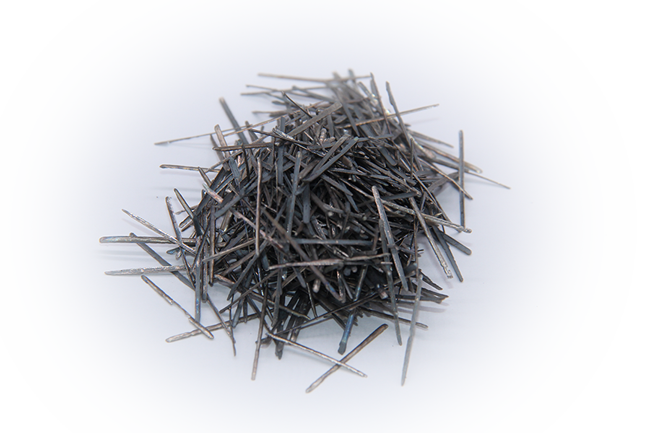Melt Drawn Heat Resistant Stainless Steel Fiber
Chemical composition
| Code | Chemical Content % | |||||
| C | P | Mn | Si | Cr | Ni | |
| 330 | ≤0.20 | ≤0.04 | ≤2.0 | ≤0.75 | 17-20 | 34-37 |
| 310 | ≤0.20 | ≤0.04 | ≤2.0 | ≤1.5 | 24-26 | 19-22 |
| 304 | ≤0.20 | ≤0.04 | ≤2.0 | ≤2.0 | 18-20 | 8-11 |
| 446 | ≤0.20 | ≤0.04 | ≤1.5 | ≤2.0 | 23-27 | |
| 430 | ≤0.20 | ≤0.04 | ≤1.0 | ≤2.0 | 16-18 | |
Psical, mechanical, hot-corrosive properties
| Performance ( Alloy ) | 310 | 304 | 430 | 446 |
| Melting point range ℃ | 1400-1450 | 1400-1425 | 1425-1510 | 1425-1510 |
| Elastic modulus at 870℃ | 12.4 | 12.4 | 8.27 | 9.65 |
| Tensile Strength at 870℃ | 152 | 124 | 46.9 | 52.7 |
| Expansile modulus at 870℃ | 18.58 | 20.15 | 13.68 | 13.14 |
| Conductivity at 500℃ w/m.k | 18.7 | 21.5 | 24.4 | 24.4 |
| Gravity at normal temperature g/cm3 | 8 | 8 | 7.8 | 7.5 |
| Weight loss after 1000hrs of cyclic oxidation % | 13 | 70(100h) | 70(100h) | 4 |
| Sharp cycling of air, Oxidation temperature ℃ | 1035 | 870 | 870 | 1175 |
| 1150 | 925 | 815 | 1095 | |
| Corrosion Rate in H2S mil/yr | 100 | 200 | 200 | 100 |
| Maximum recommended temperature in SO2 | 1050 | 800 | 800 | 1025 |
| Corrosive ratio in natural gas at 815℃ mil/yr | 3 | 12 | 4 | |
| Corrosive ratio in coal gas at 982℃ mil/yr | 25 | 225 | 236 | 14 |
| Nitridation rate in androus ammonia at 525 ℃ mil/yr | 55 | 80 | <304#>446# | 175 |
| Corrosive ratio in CH2 at 454 ℃ mil/yr | 2.3 | 48 | 21.9 | 8.7 |
| Carbon increment of alloy at 982℃,25hrs,40cycles % | 0.02 | 1.4 | 1.03 | 0.07 |
| Code | ||||||
| C | P | Mn | Si | Cr | Ni | |
| 330 | ≤0.20 | ≤0.04 | ≤2.0 | ≤0.75 | 17-20 | 34-37 |
| 310 | ≤0.20 | ≤0.04 | ≤2.0 | ≤1.5 | 24-26 | 19-22 |
| 304 | ≤0.20 | ≤0.04 | ≤2.0 | ≤2.0 | 18-20 | 8-11 |
| 446 | ≤0.20 | ≤0.04 | ≤1.5 | ≤2.0 | 23-27 | |
| 430 | ≤0.20 | ≤0.04 | ≤1.0 | ≤2.0 | 16-18 |
Raw Material And Process Of Production
The raw material is stainless steel ingots, using electric stoves which melt the stainless steel ingots to become 1500 ~ 1600 ℃ steel liquid, and then with a grooved high speed rotating melt-extracting steel wheel which produces wires that meets are our customers’ specific requirements. When melting down to a wheel steel liquid surface, the liquid steel blow out by slot with centrifugal force at extremely high speed with cooling forming. Melting wheels with water keep the cooling speed. This production method is more convenient and efficient in producing steel fibers of different materials and sizes.
Applications
Adding heat-resistant stainless steel fibers to amorphous refractory materials (castables, plastic materials, and compacted materials) will change the internal stress distribution of the refractory material, prevent crack propagation, transform the brittle fracture mechanism of the refractory material into ductile fracture, and significantly improve the performance of the refractory material.
Application areas: heating furnace top, furnace head, furnace door, burner brick, tapping groove bottom, annular furnace fire wall, soaking furnace cover, sand seal, intermediate ladle cover, electric furnace triangle area, hot metal ladle lining, spray gun for external refining, hot metal trench cover, slag barrier, various refractory material lining in blast furnace, coking furnace door, etc.
Features
Short process flow and good alloy effect;
(2) The rapid quenching process makes the steel fiber have microcrystalline structure and high strength and toughness;
(3) The cross section of the fiber is irregular crescent shaped, the surface is naturally rough, and has strong adhesion with the refractory matrix;
(4) It has good high temperature strength and high temperature corrosion resistance.
Professional technical engineer dedicated to guide you
According to your actual needs, choose the most reasonable overall design and planning procedures
